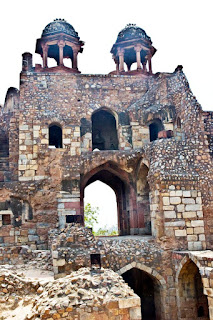The British, who occupied India, moved the capital city from Calcutta (now known as Kolkata) to Delhi in 1912. They wanted to build a new capital city so a new city was constructed adjacent to Delhi. The new city was completed in 1931 and came to be known as New Delhi. The original Delhi became Old Delhi.
Delhi lies within the Yamuna sub basin of the Ganga sytem – which itself is a part of the greater Ganga Brahmaputra Mega basin. The river Yamuna rises in the Himalaya at Yamunotri . It receives many tributaries before it debouches into the plains near Tajewala. It then travels generally along the UP – Haryana border before it reaches Delhi. Thereafter, the river runs again through UP and joins the Ganga at Allahabad.
Delhi has flat land, however there is a big depression in the southwest known as the Najafgarh jheel area, which receives the drainage from the adjoining states of Haryana and Rajasthan. The only outlet for these waters is the Yamuna.
Physically, the natural territory of Delhi can be divided into three segments – the Yamuna flood plain, the Ridge and the Plain. The Yamuna flood plain is somewhat low-lying and sandy and is subject to recurrent floods. This area is also called Khadar.
The ridge constitutes the most dominating physiographic features of this territory. It originates from the Aravali hills of Rajasthan and enters Delhi from the south extending in a north- eastern direction. Tughlaquabad fort is located on one of the highest spurs of the ridge.
Leaving aside the Yamuna flood plain (khadar) and the ridge, the entire area of the territory of Delhi is categorized as Bangar or the Plain, which is very fertile.
Everlasting refers to something that will continue to exist once it is created, while eternal implies that it has always existed and will continue to exist in the future.
The various dynasties that ruled Delhi might not have been everlasting but the eternal flowing Yamnua has been a witness to the rise and fall of these dynasties.
History has recorded different rulers/dynasties, who ruled Delhi in the past centuries, chiefly created seven principal cities that is what the whole of Delhi is as of now. Many of these are no more than villages today with splendid ruins and tales of evolution of architectural styles of the times and the synthesis of various cultures and influences. The present day skyline has now assimilated the majestic and the imperial past of these ruins.
The earliest architectural relics date back to the Maurya period (300 BC). Since then the site has seen continuous settlements. They are, Qila Rai Pithora, Mehrauli, Siri, Tughlakabad, Firozabad, Shergarh, Shahjehanabad.
Luteyn’s Delhi or the New Delhi can be termed as the Eighth Delhi as it was created during the British rule and who were the last rulers before India was declared a Sovereign Republic.

